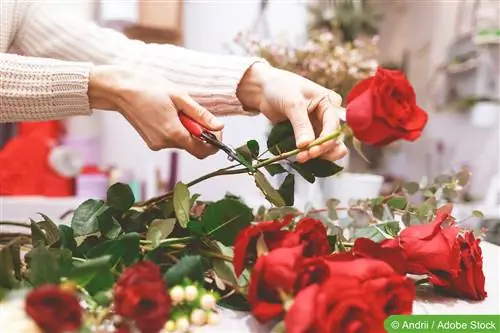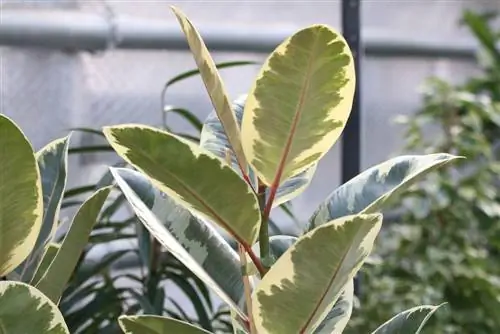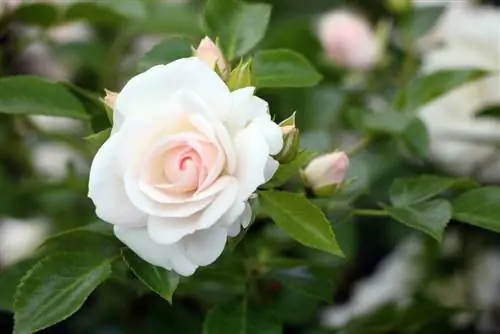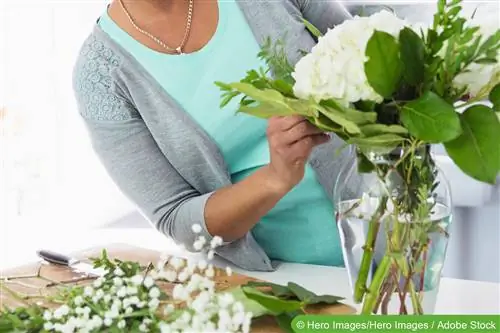- Author admin [email protected].
- Public 2023-12-17 03:39.
- Last modified 2025-06-01 06:48.
The flower heads of cut flowers regularly evaporate water in the vase. You can only maintain the fresh and plump appearance if you supply yourself with fresh water through the stem. This is only possible if the interface is clean, smooth and large. Therefore, with a correct cut you make a decisive contribution to durability.
Reasons for rapid wilting of cut flowers
A flower in a vase is not dead. You can tell this because many species take root in vases and can be used as cuttings. Theoretically, a flower can last just as long in a vase as it would on the plant. Premature death occurs due to lack of water. This is often caused by tent residue at the interface, which clogs the capillaries. Germs that accumulate at the interface also lead to blockages in the channels. Other causes are small surfaces of the interface or leaking juices from the interfaces, which lead to additional water loss.
Hygiene and proper tools improve durability
When cutting the stems, only use clean tools that cut well. Disinfect the vase and cutting tool with hot water and also use lemon juice to kill any remaining germs. Sharp knives and scissors are suitable for cutting. The best cutting tool is a sharp knife without a saw edge. Hard stems can also be cut with sharp secateurs. Household scissors are usually not sharp enough and crush the interfaces. However, these must not be crushed, but must be cut through cleanly. The stems must also not fray. If you observe crushed edges or fibrous cut surfaces after a cut, use a sharper tool to make a new cut approximately 3 cm away.
Cut the flower stems correctly
So that enough water can be absorbed through the cut surface, it must have a large surface area. A diagonal cut across the entire width of the stem results in a large oval cut surface. Cut all green, non-woody stems in this way, as long as they are not hollow inside. This cut is suitable for tulips and carnations, for example. For hollow stems, the diagonal cut is of little use; these should be cut crosswise parallel to the stem. This cut is useful for cyclamen or Christmas roses. Woody and hard stems generally have difficulty absorbing water. Help the flowers by splitting the stem and peeling off a few centimeters of bark at the bottom. Don't soften hard stems either, as this will destroy the small channels that the plants use to absorb water. In addition, large amounts of cell residues are created, which promote the colonization of bacteria.
Sliming cut flowers
Some flowers secrete a toxic mucus at the interface, which reduces their shelf life. Daffodils, lilies and hyacinths have this property. For this reason, tulips in a bouquet with daffodils, for example, only last a very short time. Place the sliming flowers separately in a container with water for at least an hour, preferably a day. Rinse the cut surface before placing the flowers in a vase as a bouquet. Do not cut the stems again.
Care for “bleeding” plants
Varieties that secrete large amounts of “milk” at the interface, like poppies or euphorbias, lose larger amounts of juice. This loss cannot be compensated for by the water in the vase. You therefore need to stop the bleeding. Briefly hold the cut surface in a gas flame. Another method to stop the discharge is boiling water. Dip the stem end into boiling water about four inches deep for ten seconds. This method also kills attached microorganisms. Nevertheless, only subject bleeding stems to this treatment.
What else should you consider with cut flowers
Remove all leaves and thorns that would later be in the water in the vase. The resulting additional open spaces improve the water supply. You also prevent the leaves from rotting and unnecessary contamination of the cut surfaces by bacteria. Since leaves cause greater evaporation, it also makes sense to remove all leaves, but this can reduce the beauty of a bouquet. Therefore, leave some of the leaves standing; decide on this point according to your personal taste. Fertilization and seed formation are undesirable in the vase, and some flowers also tend to produce large amounts of strongly colored pollen, which causes stains. Cut out the stamens from the flowers to avoid these problems.
Little tricks for longer flowers
Inflorescences in which new flowers open one after the other from bottom to top will only rarely manage to open the top flowers in vases. For gladioli and freesias, it is therefore advisable to cut off the top three buds. After cutting, the plant doesn't waste energy on flowers that won't open anyway. Therefore, the flowers underneath are stronger and last longer.
Fresh-keeping products for cut flowers
The agents hinder the growth of microorganisms and provide the plant with nutrients. Both lead to a longer shelf life. But no freshness agent can replace careful preparation and proper cutting of the stems. The cut is much more important for durability than adding water.
What you should know about cut flower care in brief
Remember that cut flowers are living plants! The flowers will only last for a long time if you look after them carefully. The most important care measure is to trim the stems properly. However, with the following little tips you can significantly extend the life of the flowers in the vase:
- The stems must be cleaned thoroughly to avoid rotting in the water.
- For this reason, all leaves at vase height must also be removed.
- The flowers should be placed in water immediately after cutting to prevent air from entering the ducts.
- It is therefore advisable to cut the stems again with a smooth knife cut and then put them in the vase immediately afterwards.
- Thorough cleaning of the vase is the top priority! You can tackle the bacteria with a brush, hot water and dishwashing liquid.
- The vase water must not be very cold - as is often wrongly assumed - but should have a temperature of approx. 35 °C.
Special nutrient solution is a true elixir of life for cut flowers. On the one hand, it inhibits the formation of bacteria and fungi and, on the other hand, it supplies the energy necessary for life. With this solution, the flowers stay fresh for significantly longer - it extends their lifespan by more than double! More tips:
- The flower vase must never be placed near fruit. This gives off a ripening gas that reduces the shelf life of plants.
- A copper coin (cent coin) in the water helps prevent the formation of rot.
- During the day, cut flowers should neither be placed in direct sunlight nor exposed to drafts.
- It is also possible to prolong life by placing the vase in a cool room overnight.
- SOS for a wilted bouquet: give it a water bath. The flowers and leaves may recover quickly.
- A dash of vinegar or lemon juice in the vase water neutralizes the limescale content of the water and prevents the development of rot.
And lastly: Can sugar be a useful flower food? - Yes, but a small pinch of sugar is enough. If you use too much, you'll achieve the opposite: the flowers will rot even faster. Sugar has the disadvantage that it promotes the growth of microorganisms. The correct dosage is a balancing act here, so it's better to avoid it and use commercially available flower food as a reliable source of nutrition.






